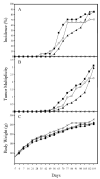Quinone reductase induction as a biomarker for cancer chemoprevention
- PMID: 16562858
- PMCID: PMC1876771
- DOI: 10.1021/np050362q
Quinone reductase induction as a biomarker for cancer chemoprevention
Abstract
Chemoprevention involves the use of natural or synthetic substances to reduce the risk of developing cancer. Strategies for protecting cells from initiation events include decreasing metabolic enzymes responsible for generating reactive species (phase I enzymes) while increasing phase II enzymes that can deactivate radicals and electrophiles known to intercede in normal cellular processes. Reduction of electrophilic quinones by quinone reductase is an important detoxification pathway. Following evaluation of approximately 3000 plant and marine organism extracts, the number characterized as "active" was established in the range of 12% of the total, and over 60 active compounds have been isolated as quinone reductase inducers. One of them, isoliquiritigenin (1), isolated from tonka bean, was shown to be a monofunctional inducer by having similar quinone reductase inducing ability in wild-type Hepa 1c1c7 cells and two mutant cell lines. To further investigate the mechanism of induction, HepG2 human hepatoma cells stably transfected with ARE-luciferase plasmid were used. Isoliquiritigenin (1) significantly induced the luciferase activity in a dose-dependent manner. On the basis of these results, a full-term cancer chemoprevention study was conducted with 7,12-dimethylbenz[a]anthracene (DMBA)-treated female Sprague-Dawley rats. Dietary administration of 1 increased tumor latency. Based on these promising preliminary results, additional mechanistic studies are underway, as well as full-term carcinogenesis studies with chronic administration schedules.
Figures


Similar articles
-
Cancer chemopreventive activity mediated by 4'-bromoflavone, a potent inducer of phase II detoxification enzymes.Cancer Res. 1999 Feb 1;59(3):578-85. Cancer Res. 1999. PMID: 9973203
-
Constituents of the stem bark of Pongamia pinnata with the potential to induce quinone reductase.J Nat Prod. 2003 Sep;66(9):1197-202. doi: 10.1021/np030207g. J Nat Prod. 2003. PMID: 14510596
-
Cancer chemopreventive potential of sulforamate, a novel analogue of sulforaphane that induces phase 2 drug-metabolizing enzymes.Cancer Res. 1997 Jan 15;57(2):272-8. Cancer Res. 1997. PMID: 9000567
-
Induction of DT-diaphorase in cancer chemoprevention and chemotherapy.Oncol Res. 1997;9(6-7):371-82. Oncol Res. 1997. PMID: 9406243 Review.
-
Chemoprotection against cancer by phase 2 enzyme induction.Toxicol Lett. 1995 Dec;82-83:173-9. doi: 10.1016/0378-4274(95)03553-2. Toxicol Lett. 1995. PMID: 8597048 Review.
Cited by
-
Enhanced Nrf2-dependent induction of glutathione in mouse embryonic fibroblasts by isoselenocyanate analog of sulforaphane.Bioorg Med Chem Lett. 2010 Apr 15;20(8):2675-9. doi: 10.1016/j.bmcl.2010.01.044. Epub 2010 Jan 20. Bioorg Med Chem Lett. 2010. PMID: 20304643 Free PMC article.
-
Effect of fingerroot on reducing inflammatory cells in hamster infected with Opisthorchis viverrini and N-nitrosodimethylamine administration.Parasitol Res. 2010 May;106(6):1485-9. doi: 10.1007/s00436-010-1809-y. Epub 2010 Mar 20. Parasitol Res. 2010. PMID: 20306207
-
Influence of diet supplementation with green tea extract on drug-metabolizing enzymes in a mouse model of monosodium glutamate-induced obesity.Eur J Nutr. 2016 Feb;55(1):361-71. doi: 10.1007/s00394-015-0856-7. Epub 2015 Feb 8. Eur J Nutr. 2016. PMID: 25663641
-
Differential Effects of Glycyrrhiza Species on Genotoxic Estrogen Metabolism: Licochalcone A Downregulates P450 1B1, whereas Isoliquiritigenin Stimulates It.Chem Res Toxicol. 2015 Aug 17;28(8):1584-94. doi: 10.1021/acs.chemrestox.5b00157. Epub 2015 Jul 16. Chem Res Toxicol. 2015. PMID: 26134484 Free PMC article.
-
Evaluation of estrogenic activity of licorice species in comparison with hops used in botanicals for menopausal symptoms.PLoS One. 2013 Jul 12;8(7):e67947. doi: 10.1371/journal.pone.0067947. Print 2013. PLoS One. 2013. PMID: 23874474 Free PMC article.
References
Publication types
MeSH terms
Substances
Grants and funding
LinkOut - more resources
Full Text Sources

